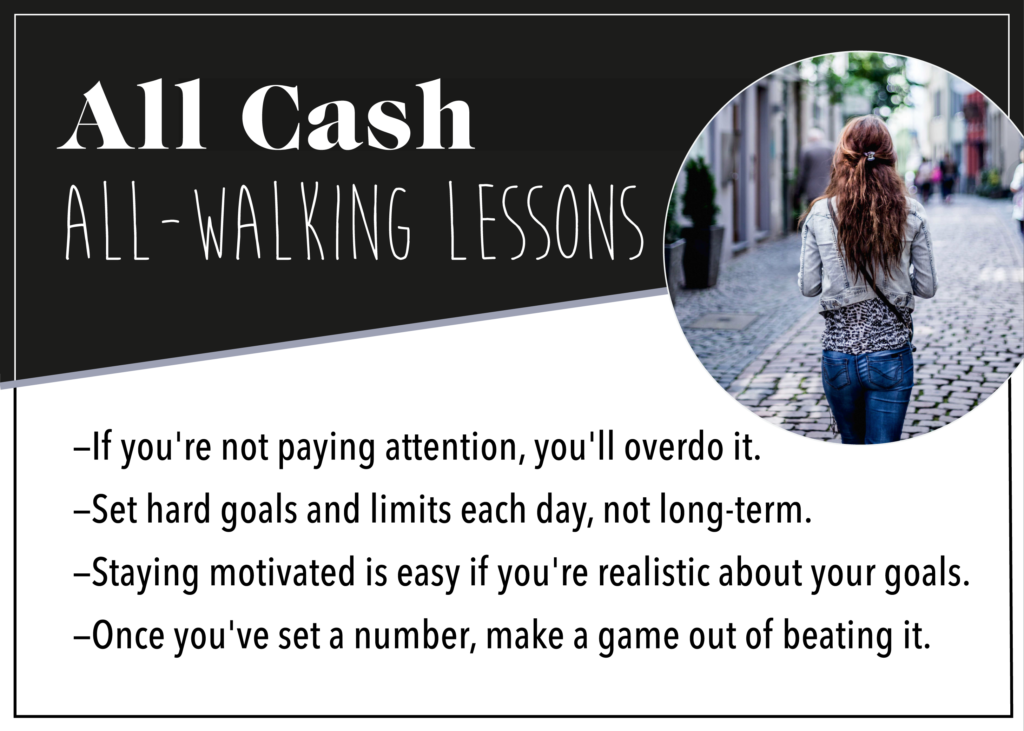What I Learned From Doing An All-Cash, All-Walking Diet

Recently, I told you guys I was embarking on a personal challenge to do a week of all-walking, and all-cash. The rules were simple: For an entire week, I could only go where my legs would take me, and could only spend money if it was in cash. (This of course didn’t include things like automated bills, but did cover everything else, from basic groceries to one-off shopping trips.) I actually took this lil’ challenge about a month ago, and believe me when I say that it took all of my personal strength not to complain about/discuss it on social media while it was going on. And yes, there was some complaining to do, because there were several moments when I really wished I could just whip out a credit card, or hop on the subway, but overall, the result was clear: I learned a lot, and am very glad I took this challenge — and will be sure to do it again from time to time, when I can feel myself getting a bit sedentary, physically and financially.
As you guys know, I’ve teamed up with Ally and Under Armour to talk about the roadmaps we all have to make to be financially and physically fit. It’s difficult (if not impossible) to truly have one without the other, because as I discussed in my last post, the choices we make with our bodies are almost directly tied to our wallets. When we opt for pricey (and unhealthy) brunches, hop into cabs instead of walking, or choose costly outings with our friends instead of, say, a bike ride and a picnic, we are making the choice to spend for a little convenience, and a little “cheat” on our health. Very quickly, those choices add up, and even if you, like me, aren’t the most athletic person in the world, it’s up to you to make the conscious effort to counteract the slow slide into sedentary spending. So I set myself this personal challenge — to undertake in tandem with Ally’s Relentless Resolutions Challenge (the winner of whom I’m meeting in Baltimore to hang out and talk all things money) — to see what I was doing wrong, and figure out how to do it better.
Somewhat unexpectedly, the lessons I gathered from both the walking and the cash-spending were incredibly similar: when you’re not paying attention, it’s easy to overdo it. A cab here or there, or feeling too lazy to make the quick walk and instead hopping on the subway, results in days where I’m clocking around 2k steps (yikes!) in a city and lifestyle where it should be incredibly easy for me to surpass 10 every day. Choosing to walk somewhere a mile away, planning my errands within walking distance, and taking the dog for two walks each day easily puts me in the range of 15k without feeling a real pinch. I sleep better at night, I feel great during the day, and my dog is happier than ever. (And considering I was able to do this challenge during winter, I can only imagine how much easier/more fun it would be in literally any other season.)

Similarly, the all-cash diet (which manifested in me taking out $300 at the beginning of the week to cover all costs) taught me just how much unnecessary crap I can accumulate when I’m not paying attention. By the end of the week, I’d only spent just over half of that money, including all of the day-to-day necessities for a household of two. It was simple: I ate more leftovers, paid close attention to my grocery shopping, turned down outings (and subbed in evenings at one of our houses, where the food and drink were a fraction of the price), and allowed myself one “going out” trip for the week — in this case, a brunch with friends. I didn’t do any random shopping, no “popping in” to pick something up when I was bored or anxious or feeling like I absolutely needed a new lip balm. (The tube of Carmex I have floating around the bottom of each purse works just fine.) Every time I handed over a bill, I felt that pang of “do I really need to be spending this?,” which is precisely what we should be feeling every time we spend money — it’s just that cards, and the distance they provide from your own money, can buffer and numb that feeling.
I found that I wanted to continue that cash diet indefinitely, and I mostly have. (The walking thing is a bit more difficult, as there are simply many engagements in New York City that are not within reasonable walking distance, especially not in winter, though I am certainly walking more!) These changes, once made, are actually not hard to sustain — and the concrete lessons they provide really do take root in your everyday decisions. The connection between how we treat our physical and financial health, and the need to keep ourselves informed and vigilant about each, become obvious once you dedicate yourself to them, even if just for a week. It’s our job to take care of ourselves, to make our fitness a priority and understand that there are no choices we make that are exempt from mattering, especially to our wallets.
Challenge yourself to do something for your wallet and your body this year, and remember that “self-care” often means making the small sacrifices in the short term (even if that means walking in nippy weather instead of grabbing a cab) so that your long-term is bright, self-determined, and full of the energy to keep moving forward.
Read more about your financial fitness with Ally.




